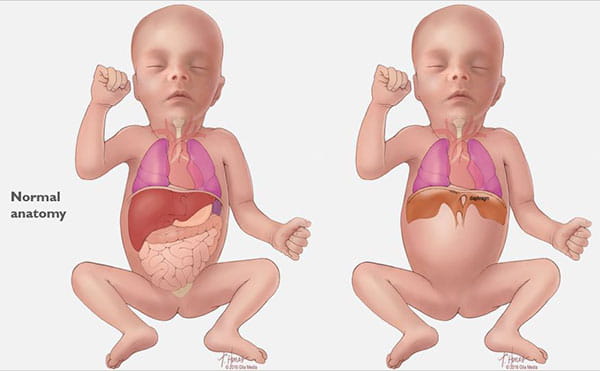Despite the advances in neonatal care, such as high-frequency oscillatory ventilation, inhaled nitric oxide, and ECMO, the mortality rate of isolated congenital diaphragmatic hernia / CDH remains substantial.
Out of frustration with these grim statistics, Harrison and colleagues pioneered fetal surgery for congenital diaphragmatic hernia / CDH. Unfortunately, survival following complete in utero repair was poor. These failures were due to herniation of the left lobe of the liver.
Reduction of the liver during repair inevitably resulted in kinking of the umbilical vein, leading to fetal bradycardia and cardiac arrest. Herniation of the left lobe of the liver became an exclusion criterion for complete in utero repair of congenital diaphragmatic hernia / CDH.
However, even if cases with left lobe herniation are excluded, the survival rate in the series by Harrison and colleagues was only 41%, which was no better than with conventional postnatal therapy at the time.
A prospective trial sponsored by the National Institutes of Health confirmed these findings; thus, there is currently no indication for complete repair of congenital diaphragmatic hernia / CDH in utero. The shortcomings of in utero repair led to development of a new approach.
Known for decades, fetal tracheal occlusion results in accelerated fetal lung growth in animal models. It was not until 1994, however, that tracheal occlusion was applied to the problem of congenital diaphragmatic hernia / CDH.
In the animal models of congenital diaphragmatic hernia / CDH, tracheal occlusion induces lung growth, increases alveolar surface area and alveolar number, as well as visceral reduction from the chest.
The results of these experiments were so compelling that fetal tracheal occlusion was applied in human fetuses with severe congenital diaphragmatic hernia / CDH.
The results of open fetal surgery for tracheal clip procedure in high-risk congenital diaphragmatic hernia / CDH were disappointing in both the UCSF and CHOP experience.
As a result of the poor outcomes with the procedure, a procedure was described using transuterine endoscopy or FETENDO. The results from the FETENDO approach in high risk congenital diaphragmatic hernia / CDH were promising and the NIH sponsored a trial of fetoscopic tracheal clip application compared to conventional postnatal therapy.
Shortly after initiation of the FETENDO trial for congenital diaphragmatic hernia / CDH the UCSF group developed a less invasive endolumenal balloon tracheal occlusion technique requiring only a single port as opposed to the 5 for the FETENDO approach. This approach, using a detachable balloon, was incorporated into the NIH sponsored trial.
The trial was halted after enrollment and randomization of 24 patients because of an unexpectedly high survival rate with standard postnatal care. The Data and Safety Monitoring Board concluded that further recruitment would not result in significant differences between the groups.
Eight of 11 (73%) in the tracheal occlusion group and ten of 13 (77%) in the group that received standard postnatal care survived. There are several important lessons to be learned from this trial.
First, these results primarily apply to fetuses with LHR > 0.9 and< 1.4.="" it="" remains="" unknown="" if="" the="" most="" severely="" affected="" fetuses="" with="" lhr="">< 0.9="" and="" liver="" herniation="" would="" do="" better="" with="" fetal="" tracheal="">
Second, the outstanding survival achieved with "standard" therapy were obtained at a tertiary center that cares for a large volume of diaphragmatic hernia patients. These results may not be generalizable to centers that do not have extensive experience caring for critically ill newborns with severe pulmonary hypoplasia due to congenital diaphragmatic hernia / CDH.
In the most severe cases of diaphragmatic hernia fetal intervention is still being investigated. In Belgium, Jan Deprest is offering fetoscopic balloon tracheal occlusion for congenital diaphragmatic hernia / CDH with LHRs less than 0.9. and herniation of the liver.
EXIT-to-ECMO
The Cincinnati Children's Fetal Care Center offers the EXIT-to-ECMO strategy as treatment for high-risk CDH.
The use of EXIT-to-ECMO was first performed by Timothy Crombleholme, MD, for the management of severe CDH (liver herniation and LHR < 0.9)="" associated="" with="" congenital="" heart="">
This has now been applied to cases of isolated high-risk CDH:
- Left-sided CDH with herniation of the left lobe of the liver and LHR ≤ 0.9, PPLV ≤ 15, TLV ≤ 18 and karyotype with no cardiac defects
- Right-sided CDH with PPLV ≤ 15 and TLV ≤ 18
The rationale for this approach is that by transitioning directly from placental support to ECMO support the infant is never hypoxic, acidotic or hypotensive and is never exposed to barotrauma from vigorous neonatal resuscitation. From a maternal risk standpoint, this approach obligates the mother to a surgical delivery.
From the fetal standpoint, because this approach is reserved for high-risk CDH, no additional fetal risk is incurred. EXIT-to-ECMO is thought to improve survival in CDH with overall survivals of 65 percent in high-risk groups of patients in which survival of 11 to 40 percent is routinely expected.




